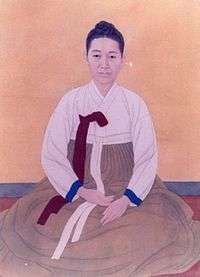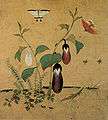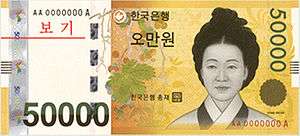Shin Saimdang

| Shin Saimdang | |
| Hangul | 신사임당 |
|---|---|
| Hanja | 申師任堂 |
| Revised Romanization | Sin Saimdang |
| McCune–Reischauer | Sin Saimtang |
| Courtesy name | |
| Hangul | 인선 |
| Hanja | 仁善 |
| Revised Romanization | Inseon |
| McCune–Reischauer | Insŏn |
Shin Saimdang (申師任堂, October 29, 1504 – May 17, 1551) was a Korean artist, writer, calligraphist, and poet. She was the mother of the Korean Confucian scholar Yi I. Often held up as a model of Confucian ideals, her respectful nickname was Eojin Eomeoni (어진 어머니; "Wise Mother").[1][2] Her real name was Inseon. Her pennames were Saimdang, Inimdang and Imsajae.
Life
Shin Saimdang was born and raised in Gangneung at the home of her maternal grandparents. Her father, Shin Myeonggwa (申命和) was a government official but did not actively join politics. Her mother was Lady Yi, the daughter of Yi Saon (李思溫). Shin had four younger sisters. Her maternal grandfather taught his hee as he would have a grandson. Being raised in that atmosphere, Shin Saimdang received an education that was not common for women of that era. Besides literature and poetry, she was adept at calligraphy, embroidery, and painting.
Because she was raised in a household that had no sons, she spent much time at her parents' home. At the age of 19, she married Commander Yi Wonsu (李元秀) and with the consent of her husband she continued to spend time at the home of her parents. She accompanied her husband to his official posts in Seoul and in rural towns and birth to Yi I in Gangneung. However, Shin Saimdang died suddenly after moving to the Pyongan region at the age of 48.[2]
Saimdang was able to cultivate her talents despite the rigid Confucian society thanks to an unconventional household and an understanding husband. Having no brothers, she received an education that would have been bequeathed only to a son, and this background greatly influenced the way she educated her children.
Works
Shin Saimdang's artwork is known for its delicate beauty; insects, flowers, butterflies, orchids, grapes, fish, and landscapes were some of her favorite themes. Approximately 40 paintings of ink and stonepaint colors remain, although it is believed that many others exist.[2]
Unfortunately not much of her calligraphy remains, but her style was greatly praised in her time, with high-ranking officials and connoisseurs writing records of her work. The scholar Eo Sukgwon of Myeongjong mentioned in his book Paegwan Japgi (hangul:패관잡기, hanja:稗官雜記, "The Storyteller's Miscellany") that Saimdang's paintings of grapes and landscapes compared to those of the notable artist Ahn Gyeon. In 1868, upon admiring the work of Saimdang, the governor of Gangneung remarked that "Saimdang's calligraphy is thoughtfully written, with nobility and elegance, serenity and purity, filled with the lady's virtue".[2]
Poetry
- Looking Back at my Parents' Home while Going Over Daegwallyeong Pass(hangul:유대관령망친정, hanja:踰大關嶺望親庭) - Poem written while leaving her parents' house, grief-stricken from leaving her mother alone
- Thinking of Parents (hangul:사친,hanja:思親) - A poem about filial devotion to her mother
Paintings
- Landscape (hangul:자리도, hanja:紫鯉圖)
- Mountains and rivers (hangul:산수도, hanja:山水圖)
- Grass and insect painting(hangul:초충도, hanja:草蟲圖)
- Geese among reeds (hangul:노안도, hanja:蘆雁圖)
 Chochungdo, a painting genre initiated by Shin Saimdang, depicting plants and insects
Chochungdo, a painting genre initiated by Shin Saimdang, depicting plants and insects Chochungdo
Chochungdo Chochungdo
Chochungdo
In modern culture

Shin Saimdang is the first woman to appear on a South Korean banknote, the 50,000 won note, first issued in June 2009. Feminist critics, however, have criticized this selection as reinforcing sexist stereotypes about women's roles.[3]
See also
References
- ↑ (Korean) Shin Saimdang at Doosan Encyclopedia
- 1 2 3 4 (Korean) Shin Saimdang at The Academy of Korean Studies
- ↑ "'Best mom' chosen as face of currency". Reuters. Nov 6, 2007.
External links
- Ojukheon & Gangneung Municipal Museum
- Shin Saimdang:Navercast
- 여성계 "신사임당 5만원권 인물 선정 유감" 연합뉴스 2007년 11월 05일자 (Korean)
- [엽기인물 한국사]6.신사임당의 남편 이원수가 아니라, 이원수의 아내 신사임당이다.① 스포츠 경향 2007년 09월 18일자 (Korean)
- <고액권 인물②> 신사임당(申師任堂) 뉴시스 2007년 11월 05일자 (Korean)
- 여성계 "5만원권 신사임당 안돼"..반발 확산 연합뉴스 2007년 11월 07일자 (Korean)
| Wikimedia Commons has media related to Shin Saimdang. |